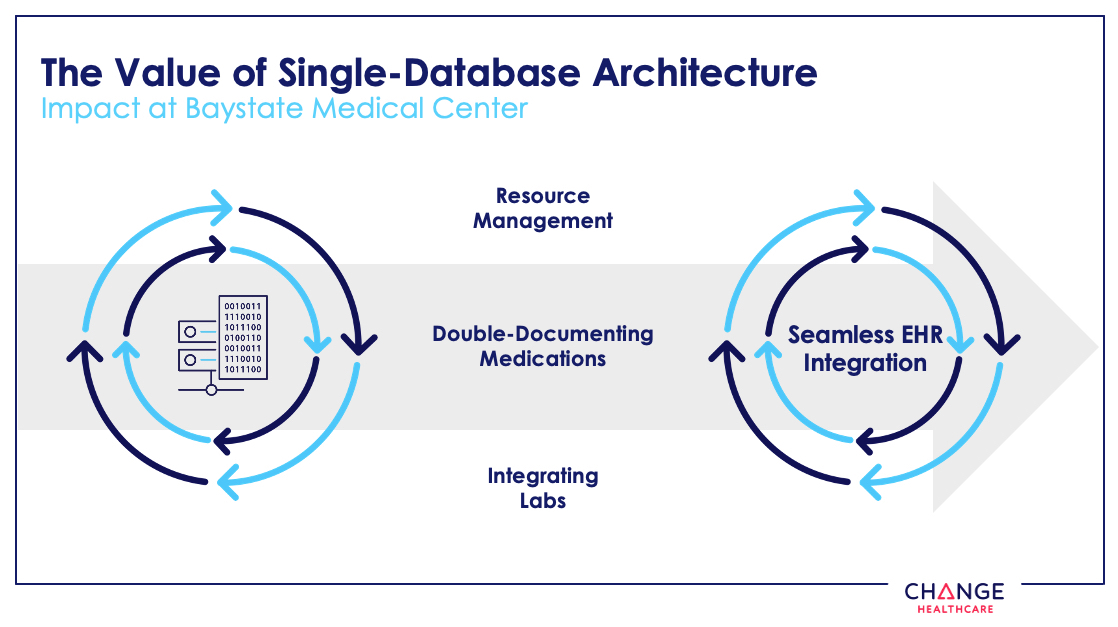
Baystate Health is an integrated healthcare system serving more than 800,000 people throughout western New England. With roots dating back to 1883, Baystate Health has provided high-quality healthcare for more than 140 years.
The system’s leading facility, Baystate Medical Center in Springfield, Mass., is the region’s only level 1 trauma center. The center has 734 beds in the interventional cardiology arena and 11 interventional cardiologists. Annually, the center performs about 5,000 procedures in the Cath lab, as well as 400 STEMIs, 300-350 TAVRs, and about 1,500 PCIs.
Incohesive Data and Manual Processes in Disconnected Cardiology Reporting Systems
Like many centers, a decade ago Baystate lacked a single database cardiovascular information system (CVIS) and structured reporting to streamline the documentation process and ensure accuracy. Its staff relied on multiple applications, cumbersome interfaces, and siloed analytics to complete reporting.
“When you don’t have a single database, your data is all over the place. Gathering analytics data reports, and trying to pull the information together from many different sources, is very time-consuming and frustrating,” said Corey McKinstry, manager of the Heart and Vascular division for Baystate Medical Center’s Cardiac Interventional Services.
“The absence of structured reporting in a single database results in time-consuming manual labor as well as less accurate and complete documentation,” McKinstry explained.
Transitioning to Structured Reporting in Cardiology
Recognizing the value of standardized reports, Baystate Medical Center worked with Change Healthcare, an independent healthcare technology company, to become an early adopter of structured reporting in cardiology imaging. In late 2011, the center began the transition to a single-database cardiology solution coupled with structured reports to achieve clinical efficiencies, reduce errors, and save time in report creation by eliminating the drawbacks of individual templates.
According to McKinstry, some of the value of having a single database is resource management. “When you don’t have structured reporting in a single database, your reports are done separately by dictation,” said McKinstry. “You have to double-document medications and jump in the EMR to enter data on a separate procedure report. Then the physician would dictate what they thought happened, and so on. And sometimes, that information doesn't align.”
Another challenge is integrating various lab work into the system. If a physician needs specific labs for calculations, they are getting the lab results from a different place and transcribing it, which can be very time-consuming and lead to errors.
“With a single database, you can sit in front of one screen and so can the physician in another department in the hospital. You can look at the physician’s report, the images, the hemo report they do during the case, and the procedural report all at once,” McKinstry explained. “If I'm questioning anything, I don't have to open three different applications or jump all over the place. It's all in front of me.”
How Does Cardiovascular Structured Reporting Help?
 Imaging is highly regulated, with multiple registries and accreditation bodies. With structured reporting, organizations can save weeks of manual work every year by mandating the collection of required data items during the reporting process and automating submissions. To manage today’s customizable clinical workflows, providers need structured reporting to improve quality and save time across the cardiovascular imaging suite. Some of the key benefits include:
Imaging is highly regulated, with multiple registries and accreditation bodies. With structured reporting, organizations can save weeks of manual work every year by mandating the collection of required data items during the reporting process and automating submissions. To manage today’s customizable clinical workflows, providers need structured reporting to improve quality and save time across the cardiovascular imaging suite. Some of the key benefits include:
• Increasing billing and reimbursement accuracy
• Harnessing structured data to optimize efficiency
• Improving report quality and accuracy
• Supporting organizational focus on patient care and quality outcomes
• Reducing administrative costs and improving productivity
“Structured reporting improves the report quality and accuracy. You can standardize statements, making sure that you get the right information, and that you don't have to repeat it,” McKinstry said. “Standardizing what we are documenting increases our billing and reimbursement accuracy, and that has been a great benefit to Baystate.”
The implementation of structured reporting at Baystate not only improved the quality of the documentation, but also the report turnaround time.
“When we were using dictation, if we had 11 interventions, we had to get 11 different formats of reports. Trying to find information in those reports was tedious, to say the least,” McKinstry said. “Then the report goes to the EMR for signature and that could take 30 days or more.”
Currently, 100% of Baystate’s interventionalists use structured reporting. As of February 2021, 92.5% are signed in within 24 hours of the procedure’s completion. Before adopting structured reporting, 89% of Baystate’s professional and hospital charges remained unsigned on reports within a five-day window, as the manual reporting process frequently took upwards of 30 days.
“We immediately saw a huge improvement in our late charges, but we hit a plateau of about 30% late charges due to improper documentation,” McKinstry said. “To fix that, we implemented a real-time billing technician who reviews the cases as they come, checking off a list of high-miss areas.”
Because the cases are reviewed in real time, errors can be addressed on the same day as the procedure, while the report is still live and the physician is still in the lab. The billing technician can simply ask the physician to un-sign the report so it can be corrected, and then sign it back in. This intervention process has helped Baystate reduce its late charges to under 10%.
“We also have auto-faxing. As soon as the physician signs the report, the system auto-faxes a copy to our referring physicians within 24 hours,” McKinstry added.
The Impact of Structured Reporting on a TAVR Program
For specific procedures, such as transcatheter aortic valve replacement (TAVR), structured reporting allows for customization of the procedural report, or hybrid reporting, through the lens of a single-database cardiology solution.
For example, Dose Area Product (DAP) or moderate sedation times can be documented in the case and imported directly into the physician’s report. Combining structured reporting and dictation for TAVR in a single-database solution allows for correlating inventory supplies. Clinicians can easily pull up every TAVR case and find any report, reducing redundant documentation.
“With TAVR, we also have interventionists and surgeons who are in a world of dictating. We included the surgeons in our structured report, and we added a field for the staff—the co-surgeon and the interventionalist—so they both show up in the report,” McKinstry said.
All billing is also done through the system for TAVR and structural heart disease.
Facing the Challenges of Structured Reporting in Cardiology
According to McKinstry, not all cardiovascular departments are equally prepared to adopt structured reporting. “There is a hill to climb. Not everybody is going to buy in to the transition, so you really need to support the physicians because this is a huge change for them.”
To maximize the adoption of structured reporting, Baystate selected a champion physician who helped to guide the whole process. As the champion physician was also one of the center’s private practice physicians, their involvement also helped improve private practice engagement. In addition, the center tasked physicians with helping to construct some of the reporting statements to ensure consistency and demonstrate the benefits of using structured reporting.
According to McKinstry, organizations must define their goals before implementing structured reporting. “Know what you want to accomplish with your organization and your departments,” she said. “We did our due diligence. We evaluated many vendors and ranked them. They all have different features; these solutions are not one-size-fits-all. You have to know what it is you need the most.”
For more information: www.changehealthcare.com
Related Cardiology Structured Reporting Content:
WEBINAR: Transforming Interventional Cardiology With Structured Reporting
Single-Database Cardiology Platform Drives Efficient Workflow and Improves Data Access


 November 14, 2025
November 14, 2025 









